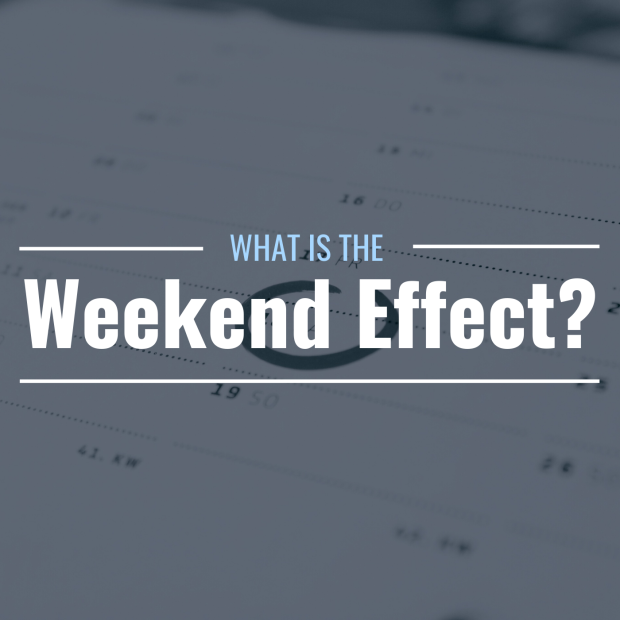
Basti93 from pixabay
The 1987 stock market crash was fueled by haphazard selling that spiraled out of control. There was no real cause for the Dow Jones Industrial Average to lose 22% of its value in one trading session, but when all was said and done, $500 billion was wiped out forever.
In the aftermath of the crash, regulators added circuit breakers to electronic trading systems, which were designed to halt trading on the New York Stock Exchange (NYSE) and Nasdaq for designated amounts of time at certain thresholds of decline: 7%, 13%, and 20%.
The hope was that by halting trading, even for a few minutes, the markets would calm down, and stability would prevail, thus preventing an even steeper, panic-fueled selloff known as capitulation.
Some might argue that these technological advances were a tipping point of sorts for the stock market, replacing previously-held rumors and superstitions that had attempted to categorize returns into discernable phenomena.
What Is the Weekend Effect?
The weekend effect was one such anomaly. This theory suggested that during periods of scheduled breaks in trading, such as over holidays and weekends, the markets did not, in fact, stabilize; rather, they saw heightened volatility and were marked by decline.
This theory was contrary to the principle behind circuit breakers, and researchers have spent decades debating whether or not it exists.
Origins of the Weekend Effect
In 1973, the Financial Analysts Journal ran an article by Frank Cross entitled “The Behavior of Stock Prices on Fridays and Mondays.” Cross, an analyst trained in academia, used statistical analysis to compare outcomes between the distribution of price changes every Friday and Monday that the stock market was open between 1953 and 1970.
Cross believed there was a correspondence between market action on Friday and Monday. Out of the 523 Fridays the S&P 500 closed higher, 49% of the time, it also made gains on the following Monday. What was even more significant, in the 313 instances where the S&P closed “down” on a Friday, it would also decline on a Monday by a margin of 3:1. This phenomenon became known as the Monday effect.
Yet, there was another phenomenon Cross discerned from his research: Monday was the worst-performing day for the stock market, as it closed “up” just 39.2% of the time, compared with the best-performing day, Friday, which rose 62% of the time. This “Monday decline” became the basis for the weekend effect.
In the decades since Cross’ article was published, hundreds of other researchers have used statistical analysis to try to prove or disprove this theory, but while they’ve noticed patterns in daily and monthly trading, their main conclusion often points to errors in others’ statistical methodology.
Even the Federal Reserve tried to debunk the phenomenon in 1998. In a paper entitled “Weekends Can Be Rough: Revisiting the Weekend Effect in Stock Prices,” economist Peter Fortune of the Federal Reserve Bank of Boston found that the weekend effect did, in fact, exist before 1987, but in the years since, negative weekend returns of any statistical significance have disappeared.
So, what would cause the weekend effect anyway? And has it appeared since?
What Causes the Weekend Effect?
Fed researchers pointed to several reasons behind the Weekend effect:
- They noticed a disparity between broker recommendations and what investors actually did on the weekend. During the week, investors were too busy to conduct their own market research and followed their brokers’ advice. They had more time over the weekend to reach their own investment conclusions, which were often sell-based.
- It took as many as five days for a trade to settle, causing stocks to typically close higher on Fridays and lower on Mondays.
- Ex-dividend dates for common stocks tended to occur on Mondays, which created a bias toward declining prices over the weekend.
- Negative corporate news releases often occurred after the Friday market close, leading stocks to open lower when the markets reopened on Monday.
“There is no economic rationale to justify the persistence of a negative weekend drift,” wrote Peter Fortune, “Rather, it might be an anomaly that was hidden from the eyes of investors but brought to light by the data mining of academics. If this is the case, the weekend effect should have disappeared after its discovery and diffusion.”
Whereas other researchers used simple diffusion models and raw data from a number of stocks to formulate their hypotheses, Fortune used a jump-diffusion model that used the S&P 500 stock index to capture the discontinuous behavior of stock prices on Friday and Monday. This allowed for the phenomenon of the “fat tail,” or a greater-than-expected extreme probability, which went largely undiscovered in pricing data prior to 1959.
Fortune’s results showed that leading up to 1987, the average weekend returns were slightly negative, although the difference was statistically insignificant. The stock market crash of 1987 had taken place on a Monday, thus skewing results drastically, and when it was removed from the sample set, the mean actual weekend return was actually slightly positive.
“In short, when the 1987 crash is excluded, the distribution of stock returns is about the same both intraweek and over weekends, with the major difference being a much lower but still positive, mean return over weekends.”
—Peter Fortune, Federal Reserve Bank of Boston, 1998
Is the Weekend Effect Real?
Interestingly, in 1999, Peter Fortune published an update to his original article in the September/October 1999 issue of the New England Economic Review. His research, now expanded, encompassed stock indices beyond the S&P 500 and included the Dow Jones Industrial Average, the Wilshire 5000, the Nasdaq Composite, and the Russell 2000. In all, his research covered 4,630 returns. The month of October 1987 was again excluded from his data set because it was so unusual.
He concluded that for large-cap indices like the Dow, the Wilshire 5000, and the S&P 500, there continued to be no evidence of pricing “drift,” or decline, over the weekend.
But smaller-cap indices like the Nasdaq and the Russell 2000 demonstrated negative weekend drift; therefore, he revised his original conclusion to state that “much of the tendency for price declines over weekends is confined to stocks of small companies.”
However, volatility over the weekend was low for both large- and small-cap indices over the period measured.
Subsequent researchers have also noticed a weekend effect in smaller-cap indices in global markets, especially in emerging markets like Hong Kong, Singapore, Malaysia, and the Philippines—some have even gone so far as to theorize that there could be a “Tuesday effect” here too, due to the time difference between New York and these exchanges.
It all just goes to show you that theories are never facts and that they can be proven, rejected, or even refined over time.







